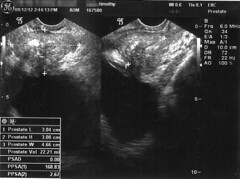Proponents of the theory of Intelligent Design love to single out the human eye as far too complex to have evolved without a guiding hand. Well, if that’s true, explain the ridiculous design of the prostate gland. OK, good job on the eye, but I want the son of a bitch that designed the prostate in my office right now. Tell him to bring his coat.
The prostate is a gland that supplies the fluid in which sperm are delivered during ejaculation. It surrounds the urethra, which is the tube carrying urine from the bladder during urination.
In about half of all men, the prostate gland begins to swell for no apparent reason around the age of 40. Like an anaconda, the growing prostate slowly constricts the urethra, causing numerous annoying symptoms, such as incontinence, difficulty urinating, or urgency of urination. Some unlucky guys develop prostate cancer or lose the ability to urinate altogether. I have achieved urgent urination status. When I need a bathroom, get the hell out of my way. Recently, during a teleconference with 20 or so attendees at which I was presenting, I had to excuse myself during the Q&A and sprint for the bathroom.
My urologist examined my blood tests and told me the good news: Not only is my prostate free of cancer, my test results indicate that I am extremely unlikely to develop prostate cancer during the remainder of my lifetime. Then he discussed my options for symptom relief.
The oldest and most common procedure involves inserting an instrument up through the urethra. The instrument has a camera, a knife blade, and a suction tube. The urologist cuts open the urethra and uses the suction tube to suck out gobs of the prostate gland, reducing its volume, thereby relieving the constriction. However, this is a surgical procedure performed under general anesthesia, requiring a hospital stay for recovery.
More modern methods involve a similar procedure, but using a laser, plasma beam or microwave device to burn away the prostate tissue. Because of the cauterization effect, it can be accomplished as an out-patient procedure without anesthesia. But there’s a catch. “The prostate has to weigh 80 grams or less,” he explained, “if it’s any bigger than that, those technologies are ineffective.”
Feeling a sense of dread, I asked, “How do you weigh it?”
“We measure it using ultrasound,” he said. I chuckled with relief, having been present during the ultrasound procedure when my wife was pregnant with our daughter. They rubbed some jelly on her abdomen, and ran a bulbous wand over her skin. So it seemed simple enough. Then he smiled, and delivered the bad news.
“To get a good image, we have to insert the ultrasound device rectally,” he told me. “You’ll have to give yourself an enema 2 hours prior to the procedure.”
I've never given myself an enema in my life. I’ll spare you the details, except to say that the best word to describe the result is “violent.” Everything inside of me that was not nailed down was expelled, including my spleen and appendix, which were not properly secured as the result of poor design.
When I checked in to the urologist’s office, I joked with the 20-something nurse behind the desk, chiding her for biting her nails, which were very short. “You don’t want me to have long nails,” she replied.
“Why not?” I asked.
“Because I’m your ultrasound technician.”
Once again, I will spare you the humiliating details. But the good news is that my prostate weighed in at a mere 22 grams, which makes me a candidate for the laser procedure.

My only hope is that the tool is well-designed, and far less bulky than that ultrasound gizmo.

No comments:
Post a Comment